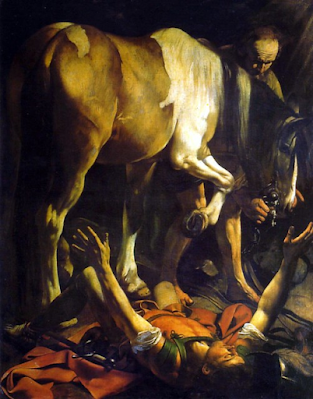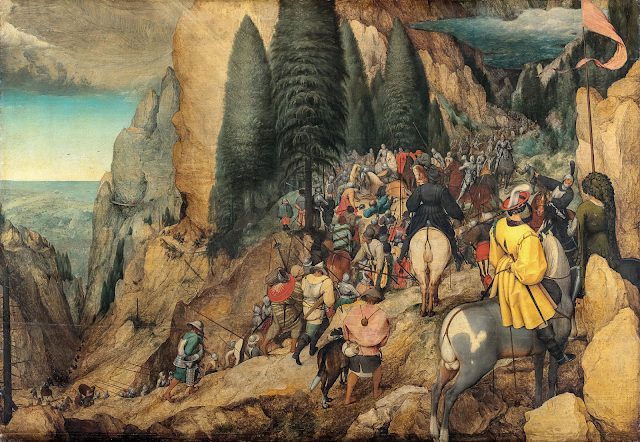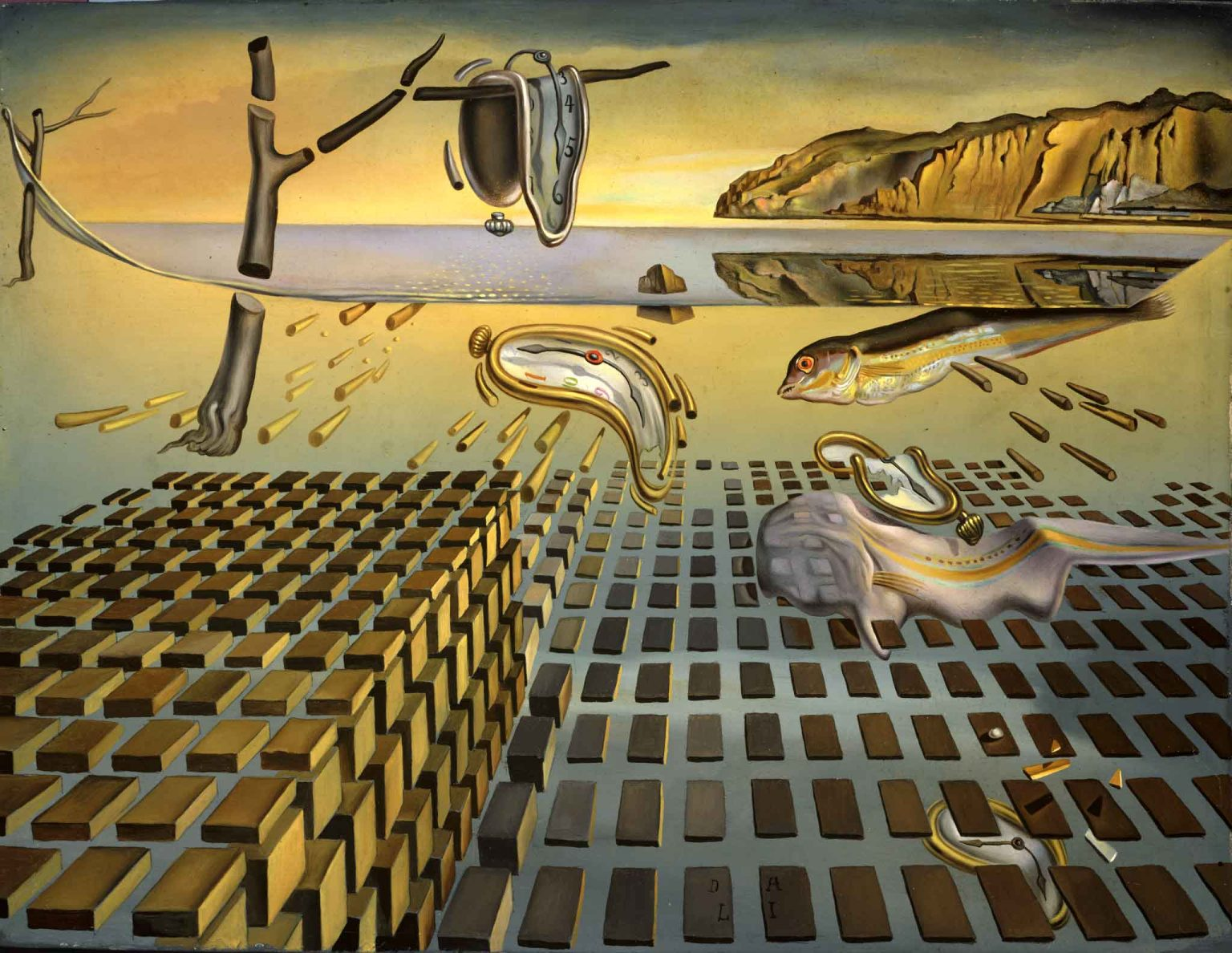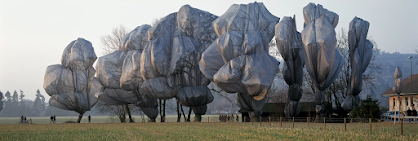Baroque Post
The Conversion of St. Paul (The Conversion of Saul) by Caravaggio
In my Renaissance Blog Post last week, I wrote about a painting called The Conversion of Paul by Pieter Bruegel. Upon researching this painting, I found that there are many paintings from the Renaissance and Baroque periods depicting this scene. I thought it would be interesting to discuss a Baroque interpretation of Paul on the road to Damascus and compare it with Bruegel's Conversion of Paul.
About the Painting:
The Conversion of St. Paul was completed by the Italian artist Caravaggio in 1601. It was commissioned by Monsignor Tiberio Cerasi to be placed in his funerary chapel in the church of Santa Maria del Popolo, which is located in Rome. Caravaggio painted this work inside the church it would later be hung in. The painting above is Caravaggio's second attempt at the painting, as the first one was rejected by Cerasi. Today, the painting can be found in the Odescalchi Balbi Collection in Rome.
Art Elements:
In my opinion, the most notable art element found in this work is tone. Caravaggio uses a form of chiaroscuro called tenebrism to create drama and place the focus on Paul. Everything else in the painting, including the background, is dark. This darkness helps to drown out the background noise of the scene and gives the viewer a very personal view of Paul. Everything but the figure of Paul reaching towards the heavens seems to be of little importance.
Along with tone, color is used to emphasize Paul's situation. This isn't a very colorful painting. The only elements of the painting that aren't brown, black, or beige are Paul's clothing and some parts of the horse. Paul's red cloak is spread across the ground, catching the eye, but also creating the illusion of movement and giving the viewer insight into Paul's current situation. The cloak looks like it just landed on the ground, indicating that this moment was captured the moment Paul fell off his horse. The large white area on the horse also captures the attention. It is located right above Paul, and seems to form an arrow pointing to him.
Paul's outstretched arms and the horse standing above him create an upside down triangle shape. This shape creates a feeling of imbalance, suspense, and movement. In the middle of this triangle the horse's hoof is lifted directly above Paul. The position of the horse's leg, combined with the light illuminating the horse's tense muscles, gives the viewer a sense of movement and creates the feeling that the hoof is going to crush Paul. A second upside down triangle can be seen in the white part of the horse's leg and body This triangle is pointing right at Paul, and helps to direct the focus toward him.
This painting inspires a feeling of suspense, as is common with Baroque paintings. Paul's facial expression and body positioning give the viewer a close look at what he is experiencing. This painting makes it easy to relate to Paul. Compared to many religious paintings, this one makes Paul look very human. I could see myself owning a copy of this. I prefer this minimalist but natural-looking style to busier, more colorful paintings. However, it isn't a painting I would enjoy looking at if I were trying to relax.
The Conversion of St. Paul and the Council of Trent:
According to Smarthistory, this painting came about as a direct result of the Counter-Reformation and the Council of Trent (Caravaggio, The Conversion of St. Paul). The Council of Trent determined that religious artwork was a valuable part of their faith, and played an active role in producing more of this artwork. One website notes that the Catholic Church revered St. Paul and considered him a foundational figure of the church (The Conversion of St. Paul by Caravaggio). Additionally, this painting was commissioned by the treasurer who worked for the pope. The Conversion of St. Paul is not as traditional as many of the works found in the churches of this time, but it does an excellent job of giving onlookers a personal and close-up look at a key religious figure.
Comparison to The Conversion of Paul (by Pieter Bruegel, 1956)
Both of these paintings depict the same event, but do so in vastly different ways. The biggest difference is the emphasis on Paul. In Caravaggio's painting, Paul is in the foreground. He's very hard to miss. Aside from Paul, there is a horse and a man, but not much else. In Bruegel's painting, however, there is a vibrantly-clothed army, as well as some very distracting landscape between the viewer and Paul. He is only visible after a thorough search. This painting portrays the scene from the perspective of an outside observer, while Caravaggio's painting makes it so the viewer can see the scene from Paul's perspective.
In this story, Paul is blinded by a light from Heaven. In Bruegel's Renaissance portrayal of this story, there is a small, faintly visible ray of light shining down on Paul from the sky. The light from Heaven looks much different in Caravaggio's Baroque depiction of this event. Tenebrism is used to create the light from Heaven. This light, which is in the process of blinding Paul, is the only source of lighting in the painting. It illuminates Paul's surprised features and parts of his horse, but leaves everything else around him a mystery.
The people in each of these paintings create distinctly different feelings. In the Renaissance painting, the soldiers are perfectly poised and seem frozen in place. Some people appear to be moving, but the movement is stiff and slow. The Baroque painting contains violent movements filled with drama. It's like a suspenseful cliffhanger that leaves the viewer wanting to see what happens next. It makes my brain wonder where Paul's arms are going and where the horse's hoof is going to land.
Each of these paintings is highly characteristic of the period they are from. The Renaissance and Baroque periods were so close together in time yet so different. It makes sense that these paintings, although they depict the same scene, would be so vastly different from one another
Works Cited:
“Caravaggio, the Conversion of St. Paul (or the Conversion of Saul).” Youtube, 24 Apr. 2017, www.youtube.com/watch?v=JftEcBnopPI&t=169s. Accessed 1 Mar. 2024.
Gurney, Tom. “The Conversion of Saint Paul by Caravaggio.” The History of Art, 14 Oct. 2023, www.thehistoryofart.org/caravaggio/conversion-of-saint-paul/. Accessed 1 Mar. 2024.
Plessis, Alicia du. ““Conversion of St Paul” by Caravaggio - an Analysis.” Art in Context, 16 Nov. 2023, artincontext.org/conversion-of-st-paul-by-caravaggio/. Accessed 1 Mar. 2024.
“The Conversion of St. Paul | Painting by Caravaggio | Britannica.” Brittanica, 3 May 2023, www.britannica.com/topic/The-Conversion-of-St-Paul-painting-by-Caravaggio. Accessed 1 Mar. 2024.






Hi Honor, I think it's very interesting to see how you've compared Caravaggio's portrayal of the event to Pieter Bruegel's interpretation. The differences in emphasis, composition, and portrayal of movement reflect the distinct artistic styles of the Baroque and Renaissance periods. Thanks for deepening our understanding of how artistic conventions and techniques evolved over time.
ReplyDelete